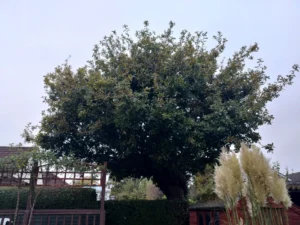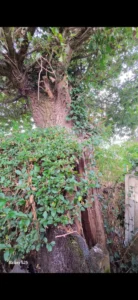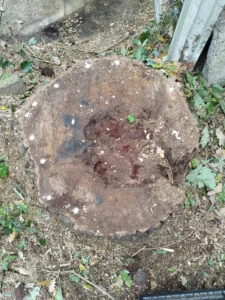We were recently instructed to carry out the removal of a large Oak tree in Cheadle Hulme, Stockport, as part of an insurance claim relating to structural damage.
The tree had become the centre of an ongoing subsidence and liability issue. Its roots were causing physical damage to two neighbouring patios, and the tree itself was in a severely compromised condition, presenting an increasing risk to the properties and residents nearby.

Why the Tree Needed Removing
This Oak was a significant specimen in terms of size but had deteriorated both above and below ground:
The roots were lifting and cracking the patios of two separate homes
The main stem showed advanced signs of heart rot, with a gaping cavity visible at the base
The tree had developed a pronounced lean, raising serious safety concerns should failure occur
An independent tree report commissioned by the insurance company confirmed that both the structural damage and safety risks were directly linked to the tree. Removal was authorised as part of the insurer’s remedial works.

RAMS and Planning
As with all insurance-related work, we provided a detailed Risk Assessment and Method Statement (RAMS) ahead of the job. This covered:
Working near boundary structures and residential patios
Method of controlled dismantling
Manual handling procedures and public safety measures
Environmental considerations and waste removal
Team roles, PPE, and first aid cover
We liaised directly with the insurer’s loss adjuster and both homeowners to ensure all parties were informed and comfortable with the scope of work.
Site Constraints
This removal presented a few technical challenges:
The Oak was situated close to two properties, with its crown extending over both gardens
Hard and soft landscaping had to be protected
Access was limited to domestic garden paths and gates — no room for large machinery
We used careful staged dismantling to ensure the surrounding area was preserved throughout the job.
Method and Execution
The job was carried out over one full day by our qualified team. Key steps included:
Establishing clear drop zones, cones, and signage to ensure safety throughout the site
Dismantling the crown in sections, with precise control to protect the patios, hedges and sheds
Removing the main stem in manageable sections, carefully navigating around the cavity and areas of internal decay
Processing and removing all timber and arisings from site
As we dismantled the tree, it became clear just how extensive the heartwood decay had become — validating the original concerns and highlighting the importance of acting when trees are structurally compromised.
Outcome
The Oak was removed safely and cleanly, with no damage to either property or the surrounding hard landscaping. The area was left tidy and ready for follow-up repairs by the homeowners.

Feedback from both property owners and the insurance company was overwhelmingly positive, with the job carried out on time, on budget, and without disruption.
Supporting Insurance and Risk-Based Tree Works
At Woodfelder Tree Care, we regularly assist insurers, surveyors, and homeowners with:
Tree removals related to subsidence, structural damage, and risk
Full RAMS and insurance documentation
Safe dismantling near buildings, patios, and shared boundaries
Follow-up support, including stump treatment and replanting advice
Whether you’re dealing with a claim or a high-risk tree, we provide honest advice, professional execution, and a clean finish every time.
Get in touch if you’d like a no-obligation quote or support with an ongoing claim.
